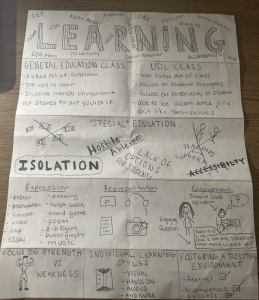Below are a few of the artifacts that students in Shaheen’s class at ISU created to synthesize what they learned in this unit.
Mj Onyeaghala (2024) Artifact
|
|
- There are implicit biases towards more traditional methods of learning such as visually through printed sources as opposed to braille which is essential for blind students.
- School systems tend to support ableism in that it oppresses disabled people by limiting their accessibility options in the classroom.
- Learning and language are subjective to each individual – there is not one correct way to communicate and express language.
|
|
|
- School systems engage in normalcy by enforcing traditional white behavioral norms within the classroom.
- Teaching is not about managing your student’s behavior to fit your expectations, but rather making connections with them to allow them to feel comfortable in the classroom environment.
- School systems have long dated back to having strict expectations of student behavior which most of the time is received as unfair and exclusionary, especially targeted towards marginalized communities.
|
|
|
- The purpose of IDEA is for school districts to find and evaluate students who are thought to have disabilities – at no cost to families.
- IDEA protects and gives rights to children with disabilities and forces schools to provide free appropriate public education to kids with disabilities.
- IEPs include special education, related services, accommodations, and assistive technology.
|
|
|
- Designs flexible learning concepts so that each student can develop their own way to engage in learning.
- Gives all students equal opportunities to succeed, no matter which methods they choose to utilize.
- In a UDL classroom, the accommodations some students might receive are available to all students. This helps reduce stigma surrounding accommodations and disability overall.
|
K-12 System that values diverse and disabled students
|
- Part of an inclusive classroom is the teacher knowing how to work with their students – making them feel seen and heard and being able to be teachable not just the teacher.
- More anti-racist teachers need to be involved in education. One way is to train and mentor educators on how to steer away from excluding marginalized communities in their classrooms.
- Learning environments should have a flexible setup and multiple approaches to completing assignments so students are still able to participate fully with class assignments and engage fully using methods most beneficial to them.
|
Mia Wagner (2024) Artifact


